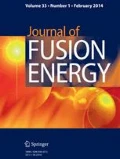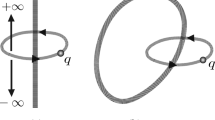Abstract
A compact torus (CT) has a toroidal magnetic and plasma geometry, but is contained within a simply-connected vacuum vessel such as a cylinder. Spheromaks and field-reversed configurations fall into this category. Compact tori are translatable and have a high engineering beta. The primary benefit of CTs for fusion is the absence of toroidal field and Ohmic Heating coils and the many problems brought on by them. Studying fusion-relevant plasma in simply-connected geometries affords the world fusion program both physics and technology opportunities not found in other configurations. This paper outlines the technology and physics opportunities of compact tori, and presents a cost model based on geometry for comparison with less compact configurations.





Similar content being viewed by others
Notes
The TF, OH and PF coils are also modeled, but the divertor is omitted to simplify the discussion.
MPD is an important measure of economy for a fusion power core, see [7] for a discussion.
References
FESAC TAP report David Hill (Chair), Rich Hazeltine (Vice Chair) http://fusion.gat.com/tap/final_report.php/
BPO ReNeW report Rich Hazeltine (Chair). David Hill (Vice Chair) http://burningplasma.org/web/renew.html
E.B. Hooper et al., ‘The Compact Torus: Spheromaks and FRCs’ white paper in preparation for this Journal
J. Sheffield, Private communication with corresponding author, June 2009
F. Najmabadi, Private communication with corresponding author August 2009
R. Stambaugh, ‘Overview of the Fusion Development Facility’ presentation given at the 2–4 March ‘Harnessing Fusion Power’ workshop, UCLA available at http://www.fusion.ucla.edu/FNST/Renew_Presentations/
R.A. Krakowski, ‘Simplified Fusion Power Plant Costing: A General Prognosis and Call for “New Think”’ Fusion Technology, March 1995, Volume 27
P.M. Bellan, Phys. Plasmas 9, 3050 (2002)
L.C. Steinhauer, Phys. Fluids B2, 3081 (1990)
W.M. Nevins, A review of confinement requirements for advanced fuels. J. Fusion Energ. 17(1), (1998)
Acknowledgments
We acknowledge John Sheffield, and Farokh Najmabadi for outlining the starting point for the discussion of cost and to Ron Miller for indicating where it might go. Thanks also to Charlie Baker for encouraging this line of thinking. Work by E. B. Hooper was performed under the auspices of the US Department of Energy by Lawrence Livermore National Laboratory under contract DE-AC52-07NA27344. S. Woodruff performed this work while supported by Department of Energy under subcontract numbers DE-FG02-06ER84449 and DE-FG02-07ER84924.
Author information
Authors and Affiliations
Corresponding author
Appendix: Matlab Cost Model
Appendix: Matlab Cost Model


Rights and permissions
About this article
Cite this article
Woodruff, S., Brown, M., Hooper, E.B. et al. Why Compact Tori for Fusion?. J Fusion Energ 29, 447–453 (2010). https://doi.org/10.1007/s10894-010-9303-1
Published:
Issue Date:
DOI: https://doi.org/10.1007/s10894-010-9303-1




